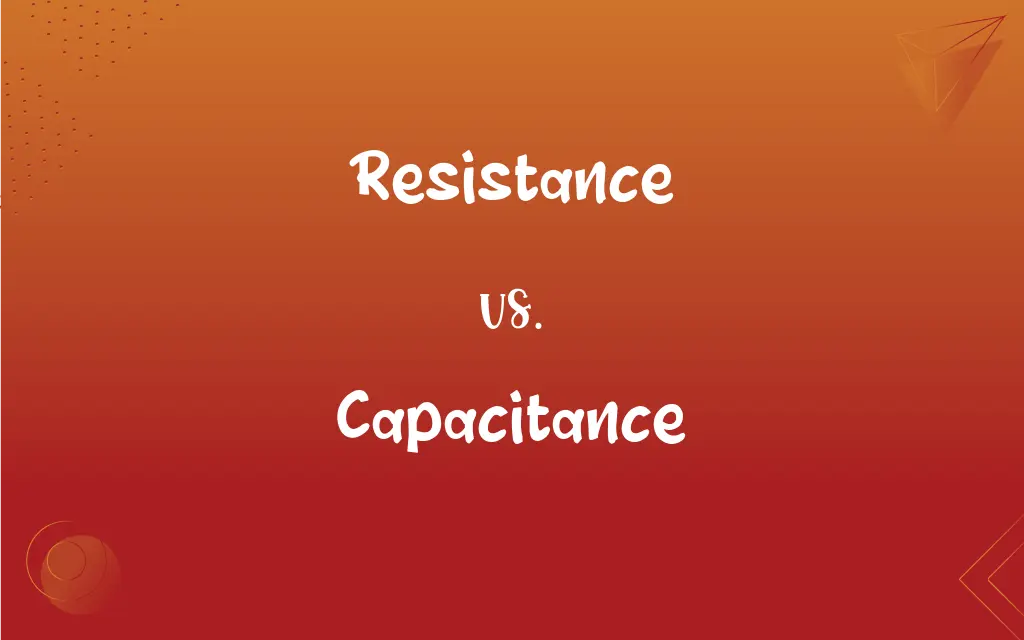Resistance vs. Capacitance: What's the Difference?
Edited by Aimie Carlson || By Janet White || Published on December 24, 2023
Resistance opposes electrical flow, measured in ohms; capacitance stores electrical energy, measured in farads.

Key Differences
Resistance is a property of a material or device that impedes the flow of electric current, often quantified in ohms. Capacitance, on the other hand, is the ability of a system to store an electric charge, measured in farads.
In resistance, the higher the value, the more it resists the current flow; it's a factor in determining how much current flows for a given voltage. Capacitance represents how much electric charge is stored for a given electric potential, influencing how a circuit responds to changes in voltage.
Resistors, the components that provide resistance, dissipate energy in the form of heat, whereas capacitors, which provide capacitance, store energy temporarily without loss. This fundamental difference reflects their distinct roles in circuits.
The concept of resistance is crucial in designing circuits to control current flow, protect components, and manage power dissipation. Capacitance is key in timing applications, filtering signals, and energy storage in electronic circuits.
Resistance and capacitance both affect an AC circuit's impedance, but in different ways: resistance dissipates energy, while capacitance stores and releases it cyclically, leading to phase shifts between current and voltage.
ADVERTISEMENT
Comparison Chart
Part of Speech
Noun
Noun
Number of Syllables
3 (re-sis-tance)
4 (ca-pa-ci-tance)
Usage in a Sentence
"The wire's resistance increased with temperature."
"The capacitor's capacitance determines its storage capacity."
Common Associated Words
Ohm, resist, impedance
Farad, store, dielectric
Derived Forms
Resistant (adjective), Resistively (adverb)
Capacitive (adjective), Capacitively (adverb)
ADVERTISEMENT
Resistance and Capacitance Definitions
Resistance
Resistance is the opposition to the flow of electric current.
The resistor's high resistance reduced the current in the circuit.
Capacitance
Capacitance is the ability of a system to store an electric charge.
The capacitor's high capacitance allowed it to power the device for a longer period.
Resistance
Resistance can refer to a material's ability to resist conductive heat transfer.
The insulation's resistance kept the house warm.
Capacitance
Capacitance can refer to the measure of a capacitor's performance in a circuit.
We need to check the capacitance to ensure the circuit functions correctly.
Resistance
Resistance can describe the effort against an opposing force in physical exercise.
He increased the resistance on the exercise bike to enhance his workout.
Capacitance
Capacitance is a key factor in determining the timing and frequency response of circuits.
Adjusting the capacitance changed the oscillator's frequency.
Resistance
In a metaphorical sense, resistance is the refusal to accept or comply with something.
Her resistance to the new policy was evident in the meeting.
Capacitance
In electronics, capacitance is the property that determines how much charge a capacitor can hold.
Increasing the capacitance can improve the device's energy efficiency.
Resistance
In biology, resistance refers to the ability of organisms to withstand harmful agents.
The bacteria developed resistance to antibiotics.
Capacitance
Capacitance involves the storage of energy in an electric field.
The enhanced capacitance was achieved by using a better dielectric material.
Resistance
The act or an instance of resisting or the capacity to resist.
Capacitance
The ratio of charge to potential on an electrically charged, isolated conductor.
Resistance
A force that tends to oppose or retard motion.
Capacitance
The ratio of the electric charge transferred from one to the other of a pair of conductors to the resulting potential difference between them.
Capacitance
The property of a circuit element that permits it to store charge.
Capacitance
The part of the circuit exhibiting capacitance.
Capacitance
The property of an electric circuit or its element that permits it to store charge, defined as the ratio of stored charge to potential over that element or circuit (Q/V); SI unit: farad (F).
Capacitance
An element of an electrical circuit exhibiting capacitance.
Capacitance
An electrical phenomenon whereby an electric charge is stored.
Capacitance
A measure of the ability of a capacitor to store electrical charge; the ratio of the charge on one plate of a capacitor to the potential difference between the plates.
Capacitance
An electrical phenomenon whereby an electric charge is stored
Capacitance
An electrical device characterized by its capacity to store an electric charge
FAQs
What units are used for capacitance?
Capacitance is measured in farads (F).
What is electrical resistance?
It's a measure of the opposition to current flow in an electrical circuit.
Can resistance be negative?
No, resistance is always a positive value.
How is capacitance increased in a capacitor?
By increasing the surface area of the plates or reducing the distance between them.
What does capacitance mean in electronics?
It refers to a capacitor's ability to store an electrical charge.
What causes resistance in a conductor?
Resistance is caused by the scattering of electrons within the conductor material.
What's the role of resistance in a circuit?
It controls the flow of current and dissipates energy.
How is resistance measured?
Resistance is measured in ohms (Ω).
Do temperature changes affect resistance?
Yes, for most materials, resistance increases with temperature.
What's the function of capacitance in a circuit?
It stores and releases energy, influencing timing and filtering.
What happens when resistance is increased in a circuit?
The current flow decreases.
Does a vacuum have capacitance?
A vacuum can have capacitance if two conductive plates are present.
Is capacitance affected by temperature?
Yes, changes in temperature can affect the dielectric properties and thus the capacitance.
Are resistors and capacitors passive components?
Yes, both are considered passive electronic components.
How does increasing capacitance affect a circuit?
It allows more charge storage and can alter the circuit's response time.
Is it possible to have negative capacitance?
In practical applications, capacitance is positive, but negative capacitance can be a theoretical concept in certain materials.
Can resistance be zero in a superconductor?
Yes, superconductors have zero electrical resistance.
Is it possible for a material to have both high resistance and high capacitance?
Generally, materials with high resistance have low capacitance and vice versa, but specific designs can achieve both.
Can resistance and capacitance be independently controlled in a circuit?
Yes, they are independent properties and can be controlled by choosing different resistors and capacitors.
How does frequency affect resistance and capacitance?
Resistance is largely unaffected by frequency, whereas capacitance can significantly influence an AC circuit's behavior at different frequencies.
About Author
Written by
Janet WhiteJanet White has been an esteemed writer and blogger for Difference Wiki. Holding a Master's degree in Science and Medical Journalism from the prestigious Boston University, she has consistently demonstrated her expertise and passion for her field. When she's not immersed in her work, Janet relishes her time exercising, delving into a good book, and cherishing moments with friends and family.
Edited by
Aimie CarlsonAimie Carlson, holding a master's degree in English literature, is a fervent English language enthusiast. She lends her writing talents to Difference Wiki, a prominent website that specializes in comparisons, offering readers insightful analyses that both captivate and inform.






























































